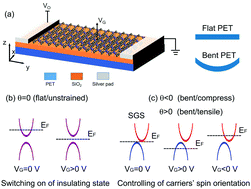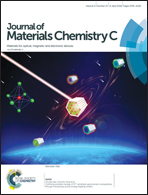Superior electronic structure of two-dimensional 3d transition metal dicarbides for applications in spintronics†‡
Abstract
The past decade has been particularly creative for spintronics since the discovery of various two-dimensional (2D) materials. However, their applications in spintronics have been limited due to the lack of intrinsic magnetism. Herein, we predict a new type of 2D transition metal dicarbides with great potential in spintronics due to the itinerant magnetism of the d orbital. It was observed that in ScC2, TiC2, CuC2 and ZnC2, no magnetism was observed. VC2, MnC2 and NiC2 are magnetic metals, and FeC2 and CoC2 are spin-polarized magnetic semiconductors. Interestingly, CrC2 is half-metallic. The large gap opening of about 15 meV in CrC2 induced by SOC is related to the p–d hybridization between the C2 dimer and Cr. The chiral edge states and Chern number results suggest that the SOC gap is topologically trivial. The uniaxial compressive strain along the y-axis can induce a transition from half-metal to magnetic semiconductor, spin gapless semiconductor and metal in monolayer CrC2. A CrC2-based field-effect transistor on a flexible substrate is proposed with the aim of realizing electrical control on the SOC-induced insulating state and on the carriers’ spin orientation. Our findings provide a new scheme for future multifunctional 2D nanoelectronics and spintronics devices.



 Please wait while we load your content...
Please wait while we load your content...